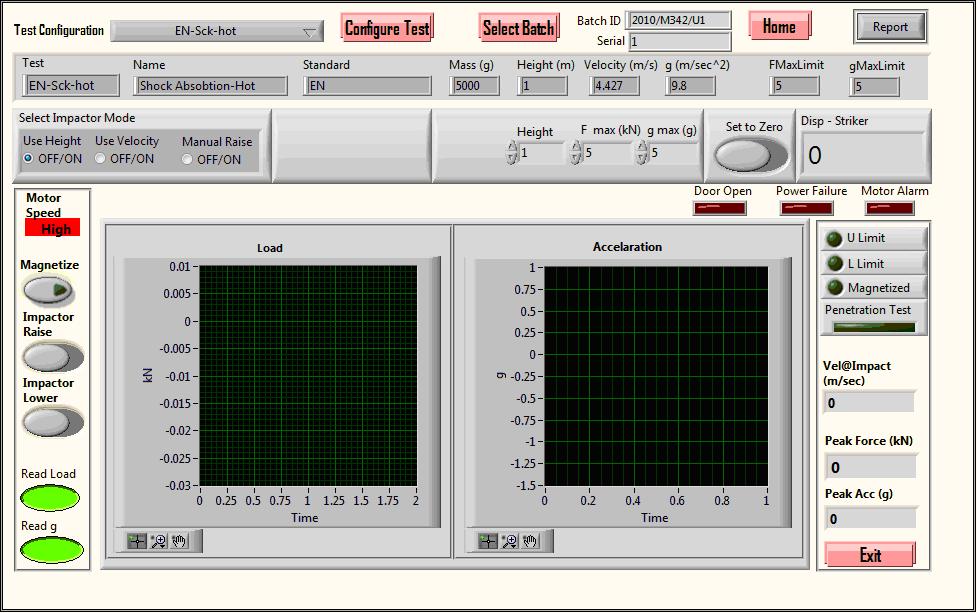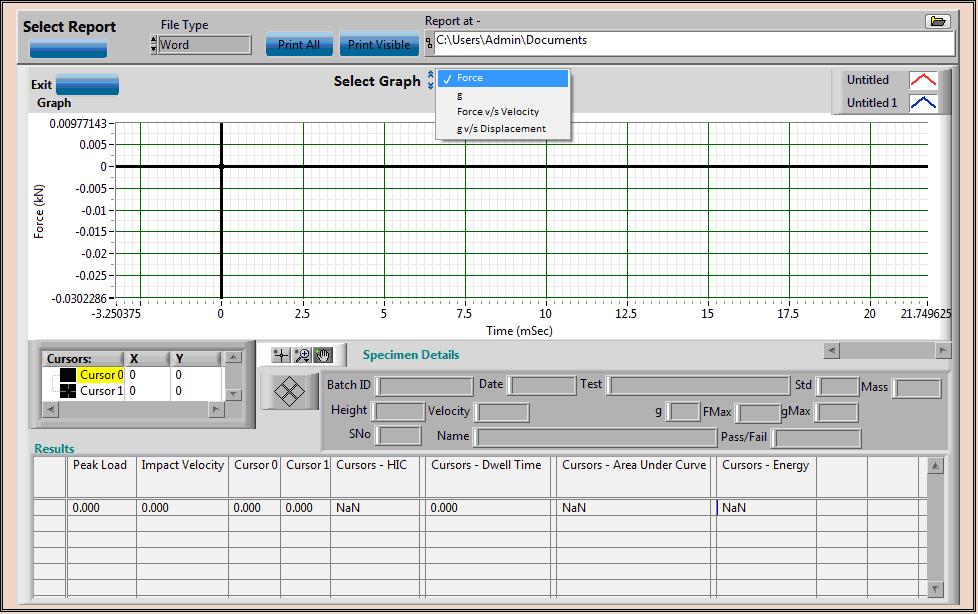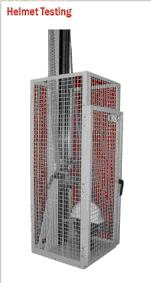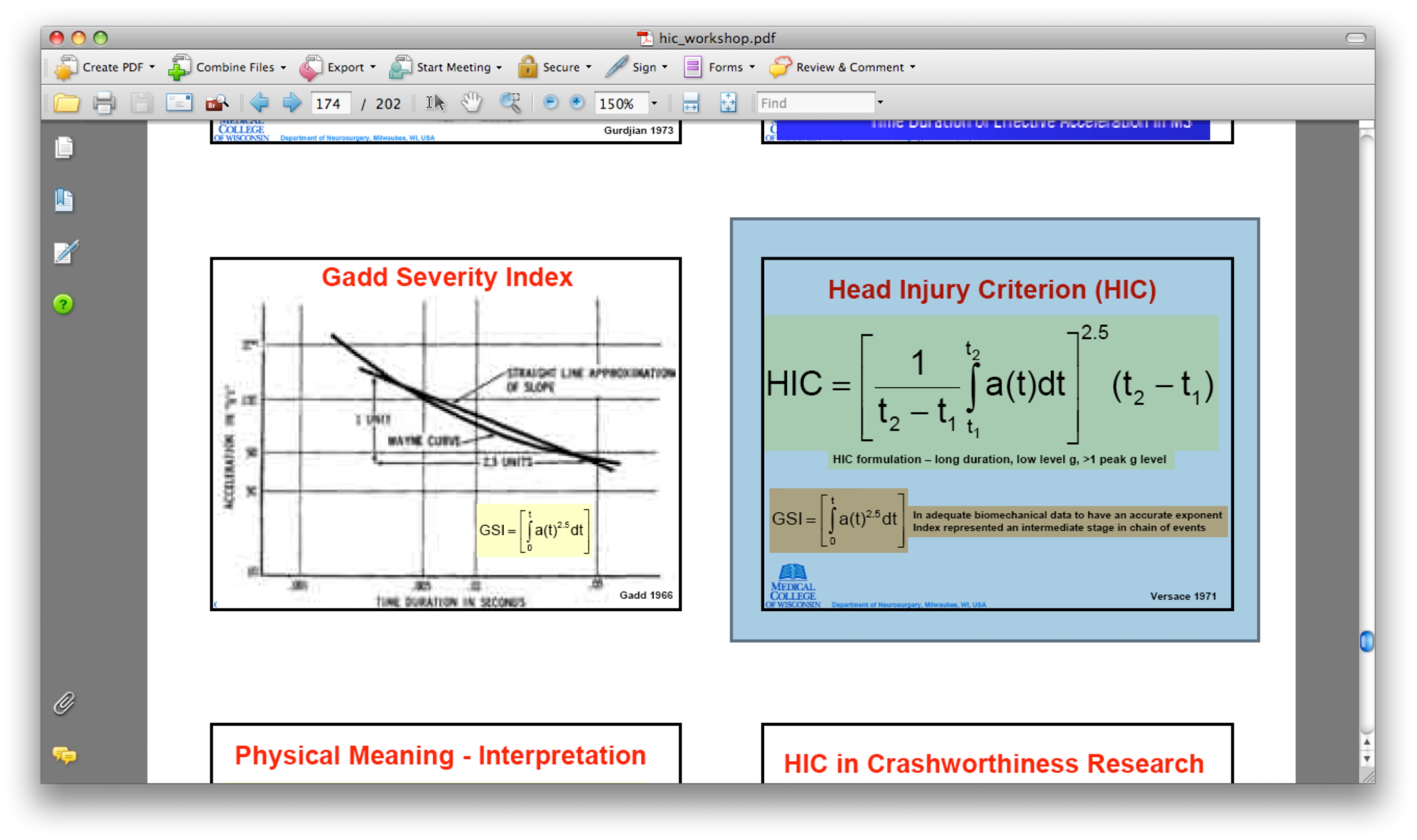This is an Impact Test System for Helmets. It precisely measures the Velocity at impact, Load, Acceleration, Displacement, Velocity (with graphs) and penetration; and calculates HIC, GSI, dwell time, area under curve, energy dispersed etc. The SCADA has reporting facility, secured database and analysis mode.

UI for Impact Testing

Application: Helmet Impact Testing is to test the impact performance of helmets at pre-defined test conditions. Conformity to standards is assessed with the use of impact head forms, data acquisition & measurement systems. An integrated software (SCADA) and mechatronic system simplifies test procedure and reduces time to test and analyse helmets’ performance for quality assurance.
Impact attenuation performance of a helmet is evaluated by releasing the helmet from a specific height in guided free fall on an impact anvil. The force transmitted to the head form is measured with an integral accelerometer (‘g’ sensor) and compared to performance limits. The impact test system has a firm pedestal, a linear bearing rail, lift carriage, drop carriage and Panasonic digitally controlled servo motor to lift the impactor (or Device Under Test ‘DUT’ depending on the test). The operator positions the helmet on the head form mounted to the drop carriage and programs the desired drop velocity in the SCADA. The drop carriage is automatically lifted to a height corresponding to the desired impact velocity. The drop tower complies with the helmet test standards as specified by ASTM, IEC, CPSC, CSA, DOT, ECE and Snell.
Physical:
Height = 8 meters
Width = 0.4 m (16 inch)
Depth = 0.5 m (20 inch)
—
Control system components:
1. Full featured control system version: NI PXI chassis with PXI 6122 & Panasonic Digitally controlled servo motor for motion control.
2. OEM version: sbRIO in lieu of NI PXI chassis
3. Low cost control system: PC & NI USB 6212 or NI PCI 6221, NI PCI 7332 for stepper motor.
and LabVIEW VI based on LabVIEW Professional Development System 2009 for PC based Test system
4. LabVIEW RT & LabVIEW FPGA for sbRIO or NI PXI chassis
Sensors:
1. SIKO Accelerometer (uni-axial or tri-axial)
2. Linear potentiometer / SIKO quadrature encoder
3. Load Cells
4. Velocity gate
Head-forms:
1. Full ISO headforms (A, E, J, M and O sizes)
2. Half ISO headforms (A, E, J, M and O sizes)
3. DOT headforms (A, C and D sizes)
Anvils:
1. Flat, Curbstone, hemispherical, edge, hazard and Cylindrical penetrator anvil & others.
2. MEP pad and spherical impactor for calibration purpose.
Drop Tower Helmet Standards List:
1. ASTM F1446:01 Basic Helmet ASTM F1045:04 Hockey
2. CPSC 16 CFR Part 1203 Bicycle
3. CSA Z262.1-M90 Ice Hockey
4. CSA Z94.1-92 Industrial
5. CSA D113.2-M89 Cycling
6. ANSI Z90.1-1992 Protective Headgear-Motor Vehicle Users
7. ECE 1078:1997 Bicycle,Rollerblade, Skateboard
8. DOT FMVSS 218 Motor Vehicle
9. PAS 015:1998 Equestrian
10. SNELL M2005 Motorized Vehicles
11. SNELL B95 Bicycle
12. SNELL E2001 Equestrian Helmet
14. SNELL S98 Alpine Ski
15. ECE BS EN 1384:1997 Motorcycle
16. BS EN 1077:1996 Alpine Ski
Overview:
The application software (LABVIEW VI) is a user-friendly data acquisition program specifically designed for helmet certification and performance testing. The LABVIEW VI interfaces with
helmet test apparatus via data acquisition system and motion control board. The LABVIEW VI will control and/or collect test measurements from an impact tower, retention testers, roll-off
tester, mass property instrument, helmet rigidity tester and linear impactor.
Operation:
Prior to the commencement of testing, database fields incorporated in the LABVIEW VI (NI Database Connectivity Toolkit) simplify record keeping and report generation (NI report generation toolkit) once testing is completed.
Information such and sizing, helmet identification, conditioning environments and test standard can be entered and are stored with the test data. Test screens specific to the test apparatus, standards & routine in th LABVIEW VI simplify the performance of pre and post-test instrument verification and the entire test sequence on a helmet. The results from each test are instantly displayed both numerically and graphically. The data are also saved to DB for review at a later date. When testing is complete, the LABVIEW VI instantly facilitates a test report that can be sent directly to any printer installed on the computer (including PDF) or by email to mentioned recipient.
Test Result Documentation includes:
Impact attenuation
Retention elongation
Helmet stability
Penetration resistance
Mass, CG and moment of inertia.
Calculations:
Peak acceleration & acceleration graph
Peak load & load graph
Impact velocity
Impact energy
‘HIC’
‘GSI’
Dwell time at various g levels

- Captures and analyses data from Helmet Impact Tests
- Displays Data graphically and provides for analysis as per any test standard (listed on this page)
- Solves for the triaxial resultant vector, HIC and Severity Index
- Measures cushion material compression
- X-Y plot for instrumented chin strap testing
- Fully automated operation with zero room for error
- All latest test standards’ procedures are pre-programmed in the tests sequences
- Exports data for analysis to Microsoft Excel, PDF, HTML, Screen and open formats.
- The test data can be automatically uploaded to Amazon AWS or Microsoft Azure Cloud portal securely.
- User can monitor tests and view results on Android and iOS Apps securely using password and OTP

The entire system is available with either National Instruments platform or SureView Ethernet based data acquisition systems. We have over 2 decades of experience in PC based test, measurement and automation. We have used reputed displacement sensors and load cells. The digitally controlled servo motor provides for accuracy below microns. The system is suitable for any standard for impact testing of helmets.
